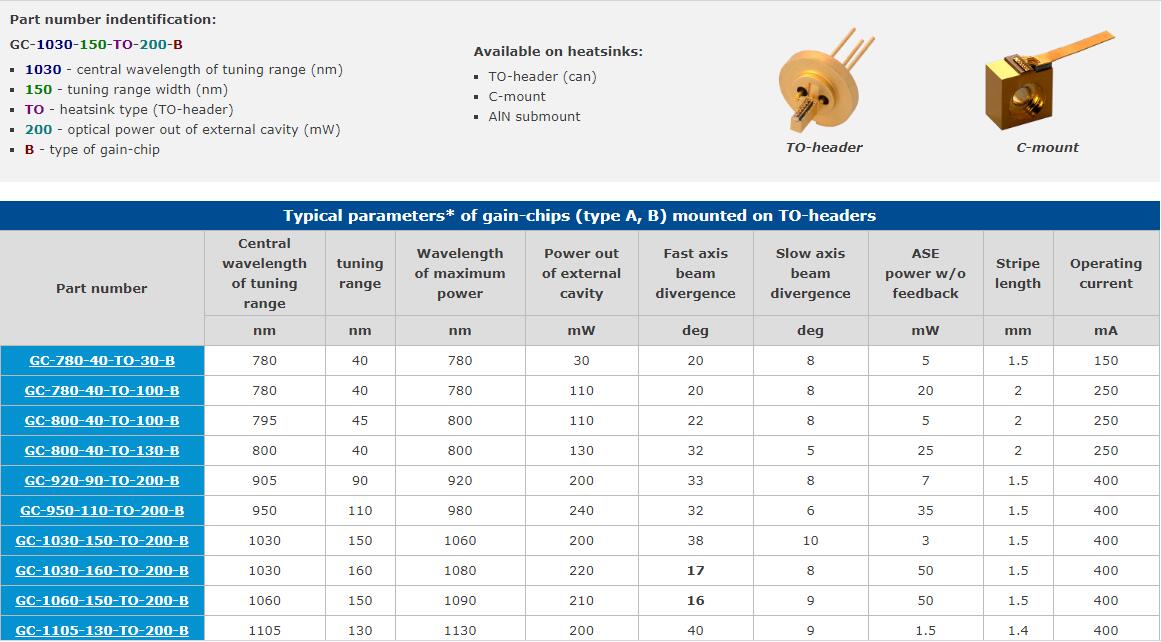Gain-chip is the irreplaceable component as a gain medium for the building of the tunable diode laser or high stable external cavity diode laser. Gain-chip is similar to laser diode chip except the fact that it has deep antireflecting coating on one or both facets which significantly increases threshold of self lasing or eliminate it.
Typical external cavity diode laser configurations are Littrow- and Littman/Metcalf cavities. For the Littrow configuration, a diffraction grating is mounted in a way that light of the desired wavelength is diffracted back along the incident beam. Wavelength is scanned by rotating the grating. Generally an intracavity achromatic lens is used to collimate expanded beam on a relatively large area of the grating. The zero order diffracted beam can be used as the output laser beam.
|

Littrow configuration
|

Littman/Metcalf configuration
|


Innolume Gain-chip product line subdividing in two main categories:
-
One side optical access (Types A and B)
-
Two sides optical access (Types C and D)
One side optical access Gain-chip is ideal component for operation in the scheme where the output power is outcoupled from the external cavity. Typically they are supplied in TO-can package.
Two sides optical access Gain-chip can be used in scheme allowing power outcoupling directly from the Gain-chip Facet to reduce the optical losses or in optical scheme for the amplification.
Type A Gain-chip has straight stripe normal to the facets with high reflecting (HR) and deep antireflecting (AR) coatings. This is the most cost effective solution for the building of the external cavity diode laser. Type A GC has symmetrical beam far field providing efficient coupling to the external cavity and back using high NA aspheric lens. This type of the Gain-chips has relatively low gain spectra ripples suppression compare to the other types. It results from the fact that the reflection of the AR coated facet is on the level of 0.1% and can be further reduced by using curved stripe-to-facer design only.
Type B GC has curved stripe with HR- on normal side and deep AR-coating on the tilted one. The curved stripe together with deep AR-coating provides extremely low reflection (< 10E-5) allowing suppression of self lasing and minimizing of gain ripples. The drawback of the curved stripe is the distortion of the output beam which embarrasses collimation and reduces efficiency of back coupling. High NA optics must be used.
Type C GC has curved stripe and deep AR-coating at the tilted side and a few percent reflection at the normal side. The wavelength selecting feedback has to be placed at the tilted side (with the same advantages and drawbacks as for the Type B), whereas the output power goes out from the normal side. This design allows high output power and relatively good output beam. The reflection of the facet with normal stripe has to be designed individually depending on the configuration of the system and required output power.
Type D GC has a tilted stripe with a deep AR on both sides, typically it used for the advanced optical schemes were the build-in amplifying unit is needed. Innovative facet coating technology which includes facet passivation meets high reliability requirements. The ISO9001:2008 conform production is based on careful design, manufacturing and extensive testing. Each device is individually tested and shipped with a specified set of test data.